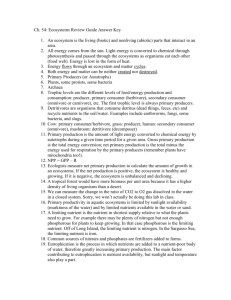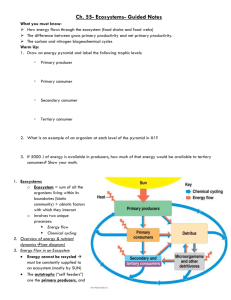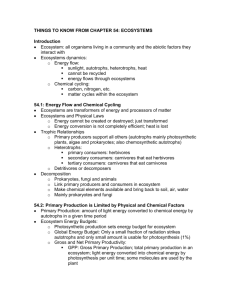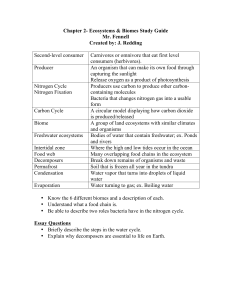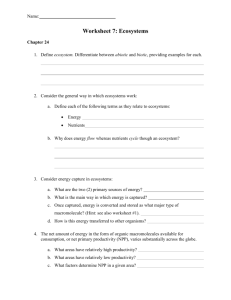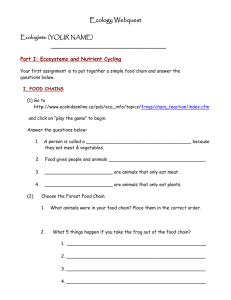Chapter 54 - BiologyAlive.com
advertisement
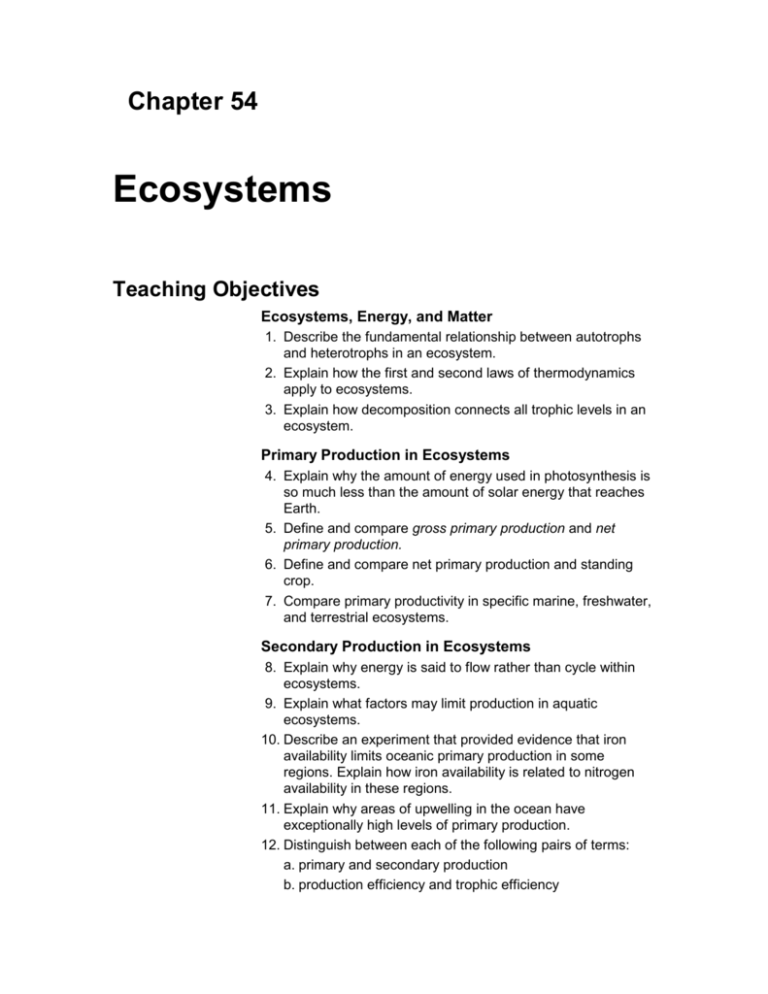
Chapter 54 Ecosystems Teaching Objectives Ecosystems, Energy, and Matter 1. Describe the fundamental relationship between autotrophs and heterotrophs in an ecosystem. 2. Explain how the first and second laws of thermodynamics apply to ecosystems. 3. Explain how decomposition connects all trophic levels in an ecosystem. Primary Production in Ecosystems 4. Explain why the amount of energy used in photosynthesis is so much less than the amount of solar energy that reaches Earth. 5. Define and compare gross primary production and net primary production. 6. Define and compare net primary production and standing crop. 7. Compare primary productivity in specific marine, freshwater, and terrestrial ecosystems. Secondary Production in Ecosystems 8. Explain why energy is said to flow rather than cycle within ecosystems. 9. Explain what factors may limit production in aquatic ecosystems. 10. Describe an experiment that provided evidence that iron availability limits oceanic primary production in some regions. Explain how iron availability is related to nitrogen availability in these regions. 11. Explain why areas of upwelling in the ocean have exceptionally high levels of primary production. 12. Distinguish between each of the following pairs of terms: a. primary and secondary production b. production efficiency and trophic efficiency 13. Explain why the production efficiency of a human is much less than the production efficiency of a mosquito. 14. Distinguish among pyramids of net production, pyramids of biomass, and pyramids of numbers. 15. Explain why aquatic ecosystems may have inverted biomass pyramids. 16. Explain why worldwide agriculture could feed more people if all humans consumed only plant material. 17. Explain the green-world hypothesis. Describe five factors that may act to keep herbivores in check. The Cycling of Chemical Elements in Ecosystems 18. Describe the four nutrient reservoirs and the processes that transfer the elements between reservoirs. 19. Name the main processes driving the water cycle. 20. Name the major reservoirs of carbon. 21. Describe the nitrogen cycle and explain the importance of nitrogen fixation to all living organisms. Name three other key bacterial processes in the nitrogen cycle. 22. Describe the phosphorus cycle and explain how phosphorus is recycled locally in most ecosystems. 23. Explain how decomposition affects the rate of nutrient cycling in ecosystems. 24. Describe how net primary production and the rate of decomposition vary with actual evapotranspiration. 25. Describe the experiments at Hubbard Brook that revealed the key role that plants play in regulating nutrient cycles. Human Impact on Ecosystems and the Biosphere 26. Describe how agricultural practices can interfere with nitrogen cycling. 27. Explain how “cultural eutrophication” can alter freshwater ecosystems. 28. Describe the causes and consequences of acid precipitation. 29. Explain why toxic compounds usually have the greatest effect on top-level carnivores. 30. Describe how increased atmospheric concentrations of carbon dioxide could affect Earth. 31. Describe the causes and consequences of ozone depletion. Student Misconceptions 1. The pyramid of numbers refers to the number of organisms at each trophic level of a food web; the pyramid of biomass refers to the biomass of organisms at each trophic level of a food web. Students may generalize and think that the pyramid of production is based on the energy “stored” in organisms at each trophic level of a food web. Point out to your students that the pyramid of production is based on the production of each trophic level, measured in energy per unit area per unit time or in biomass added to the ecosystem per unit area per unit time. Explain the importance of the inclusion of time in the measure of production, and clarify why time is not a unit in measure of biomass or numbers. 2. Students may view biogeochemical cycles as confusing and boring abstractions. Discuss the crucial role of prokaryotes, especially in the nitrogen cycle, and point out that life on Earth would end without prokaryotic nitrogen fixation. Point out that nutrients may change in chemical form as they move through food webs. Look for interesting and locally relevant examples to illustrate the effects of nutrient availability on community structure and to clarify the concept of limiting factors. 3. Emphasize to students that ecosystems are open systems, and that they are not self-sufficient or self-contained. Students know that energy in the form of sunlight enters ecosystems. They are less likely to realize that an area of high productivity may feed an adjacent area of low productivity or to recognize that a population with a high reproductive rate may be a source of recruits for an adjacent population with a lower reproductive rate. Chapter Guide to Teaching Resources Overview: Ecosystems, energy, and matter Concept 54.1 Ecosystem ecology emphasizes energy flow cycling and chemical Transparency Figure 54.2 An overview of energy and nutrient dynamics in an ecosystem Concept 54.2 Physical and chemical factors limit primary production in ecosystems Transparencies Figure 54.4 Net primary production of different ecosystems Figure 54.5 Regional annual net primary production for Earth Figure 54.6 Which nutrient limits phytoplankton production along the coast of Long Island? Table 54.1 Nutrient enrichment experiment for Sargasso Sea samples Figure 54.8 Actual evapotranspiration (temperature and moisture) related to terrestrial net primary production in selected ecosystems Figure 54.9 Is phosphorus or nitrogen the limiting nutrient in a Hudson Bay salt marsh? Instructor and Student Media Resources Investigation: How do temperature and light affect primary production? Video: Cyanobacteria Concept 54.3 Energy transfer between trophic levels is usually less than 20% efficient Transparencies Figure 54.10 Energy partitioning within a link of the food chain Figure 54.11 An idealized pyramid of net production Figure 54.12 Pyramids of biomass (standing crop) Figure 54.13 A pyramid of numbers Figure 54.14 Relative food energy available to the human population at different trophic levels Student Media Resources Activity: Pyramids of production Graph It: Animal food production efficiency and food policy Concept 54.4 Biological and geochemical processes move nutrients between organic and inorganic parts of the ecosystem Transparencies Figure 54.16 A general model of nutrient cycling Figure 54.17 Nutrient cycles: The water cycle Figure 54.17 Nutrient cycles: The carbon cycle Figure 54.17 Nutrient cycles: The nitrogen cycle Figure 54.17 Nutrient cycles: The phosphorus cycle Figure 54.18 Review: Generalized scheme for biogeochemical cycles Figure 54.19 Nutrient cycling in the Hubbard Brook Experimental Forest: An example of long-term ecological research Student Media Resources Activity: Energy flow and chemical cycling Activity: The carbon cycle Activity: The nitrogen cycle Concept 54.5 The human population is disrupting chemical cycles throughout the biosphere Transparencies Figure 54.21 Distribution of acid precipitation in North America and Europe, 1980 Figure 54.22 Average pH for precipitation in the contiguous United States in 2002 Figure 54.23 Biological magnification of PCBs in a Great Lakes food web Figure 54.24 The increase in atmospheric carbon dioxide at Mauna Loa, Hawaii, and average global temperatures over land from 1958 to 2004 Figure 54.26 Thickness of the ozone layer over Antarctica in units called Dobsons Figure 54.27 How free chlorine in the atmosphere destroys ozone Student Media Resources Activity: Water pollution from nitrates Activity: The greenhouse effect Graph It: Atmospheric CO2 and temperature changes For additional resources such as digital images and lecture outlines, go Campbell Media Manager or the Instructor Resources section of www.campbellbiology.com. Key Terms actual evapotranspiration biogeochemical cycle biological magnification critical load decomposer detritivore detritus ecosystem eutrophication greenhouse effect green world hypothesis gross primary production (GPP) limiting nutrient net primary production (NPP) primary consumer primary producer primary production production efficiency secondary consumer secondary production to the tertiary consumer trophic efficiency turnover time Word Roots auto- 5 self; -troph 5 food, nourishment (autotroph: an organism that obtains organic food molecules without eating other organisms) bio- 5 life; geo- 5 the Earth (biogeochemical cycles: the various nutrient circuits which involve both biotic and abiotic components of ecosystems) de- 5 from, down, out (denitrification: the process of converting nitrate back to nitrogen) detrit- 5 wear off; -vora 5 eat (detritivore: a consumer that derives its energy from nonliving organic material) hetero- 5 other, different (heterotroph: an organism that obtains organic food molecules by eating other organisms or their by-products) Instructor’s Guide for Campbell/Reece Biology, Seventh EditionChapter 54 Ecosystems Instructor’s Guide for Campbell/Reece Biology, Seventh EditionChapter 54 Ecosystems Instructor’s Guide for Campbell/Reece Biology, Seventh Edition


